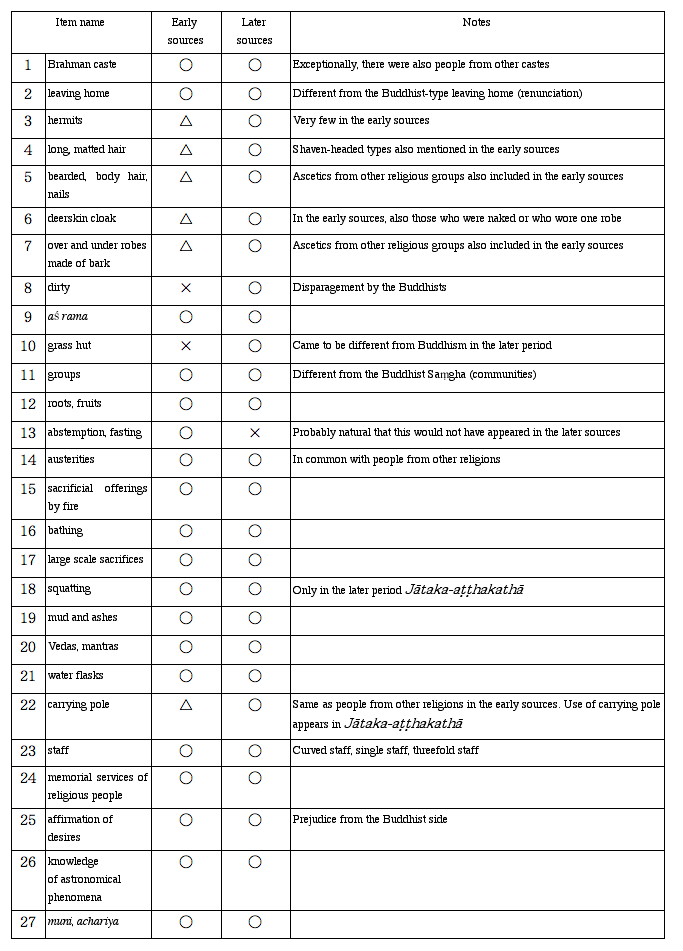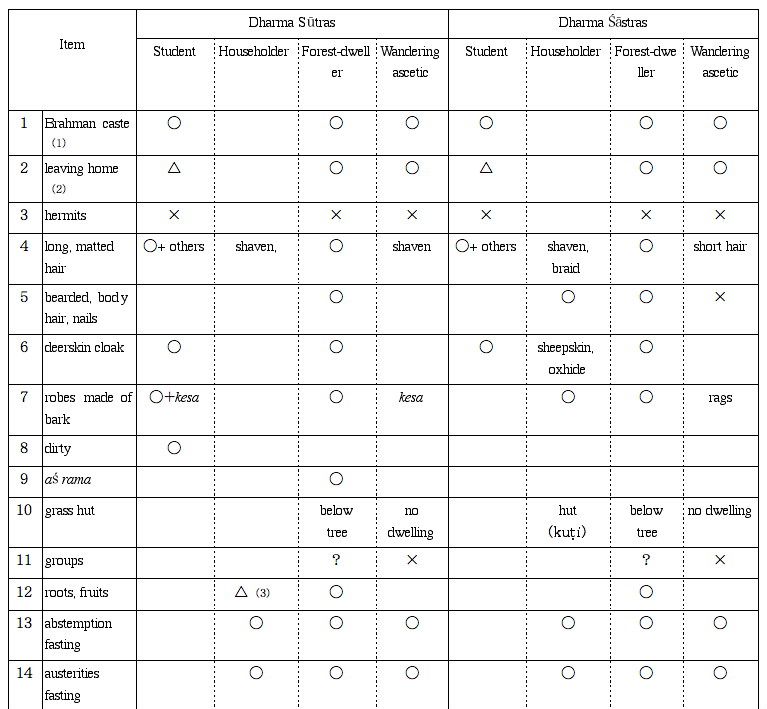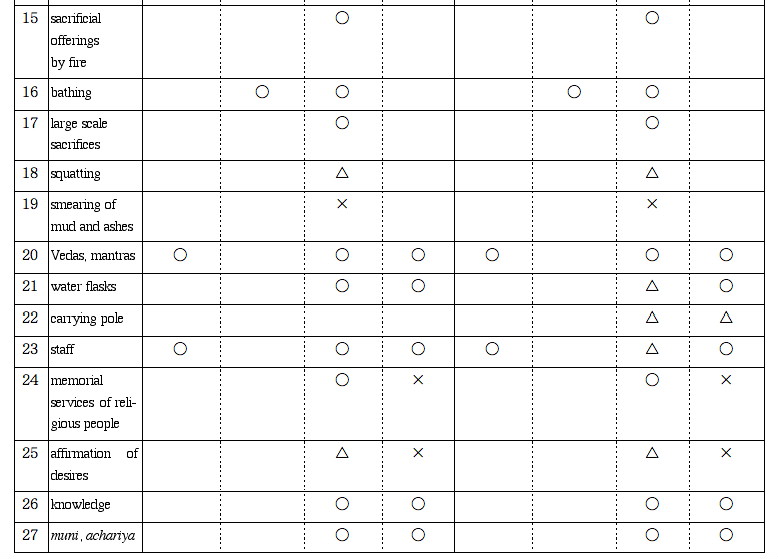
Introduction
1. The three Kassapa brothers as matted-haired ascetics (jaṭila)
2. Chinese translation of jaṭila and written sources for investigating the term
3. Materials for jaṭila in the early Buddhist sources
4. Materials for jaṭila in the later Buddhist sources
5. Special characteristics of jaṭila
6. Appearance of jaṭila
7. Living conditions of jaṭila
8. Food of jaṭila
9. Ascetic modes of jaṭila
10. Appurtenances of jaṭila
11. Other characteristics of jaṭila
12. Jaṭila recorded in the early Buddhist sources
13. Jaṭila, and the life of Brahmans during the period of forest-dwelling and wandering, as recorded in the Dharma Sutras
14. The life of jaṭila, and the life of bhikkhus and bhikkhunis as regulated in the Vinaya
15. Why the episode of the three Kassapa brothers was recorded in the First Khandaka (The Admission to the Order of the Bhikkhus)
 |
early Buddhism, Brahman ascetics, jaṭila (matted hair ascetics), vānaprastha (forest dwellers), wanderers, Dharma Sutras, Dharma Śāstras, food, clothing and lodging, lifestyles |

The First Khandaka of the Mahavagga in the Vinaya is famous for its account of the Buddha's life after his enlightenment. However, it is risky to read it as a fully-fledged Buddha biography. This is because all of the events recorded there are intended to demonstrate the circumstances under which the ordination ceremony (upasampada) came to into being as the formal procedure for entering the Saṃgha. In other words, the events were used to confirm the validity of the initial and intermediate stages in the evolution of the upasampada, the ordination ritual characterized by the presence of ten monks and the inclusion of the four-announcement ceremony (jňapticaturthakarman). The earliest form was the simple invitation of the Buddha, "Come, monk" (ehi-bhikkhu-upasampadā); the intermediate stage was ordination by the candidate's repeating three times, "I take refuge in the Buddha, the Dhamma and the Samgha" (ordination through the Triple Refuge). Thus the episodes describing the Buddha's enlightenment, his first discourse and the five bhikkhus taking refuge record the development of the Triple Refuge in the Three Treasures and how ordination through the Triple Refuge came about. This is because sending the disciples throughout the land to teach had its origins in the development of these precepts. The reason for noting the conversion of King Bimbisāra and of Sāriputta and Moggallāna was, on the other hand, to explain the causes and conditions through which upasampada ordination (with the presence of ten monks and the inclusion of the four-announcement ceremony) was formulated.
The accounts that appear to be biographical in the First Khandaka are actually part of the history of the formulation of that ordination ceremony, and were not intended to be biographical. The Buddha must have done many other things immediately after his enlightenment but they were excluded because they did not relate directly to the subject of interest. The Nidānakathā, well-known as a biographical work, tells us that there was exactly a year between the Buddha's enlightenment and his return home to Kapilavatthu; probably the impression we receive of this being a such short space of time is due to the fact that almost certainly many of the exploits of the Buddha were omitted. We feel that the time that elapsed between the two events is more likely to have been ten years.
Thus it is very risky to read the accounts written here as biography. However, the episode concerning the Kassapa brothers is of a different nature and it is not at all clear why it was included when the First Khandaka was compiled. There are as well many anomalies regarding the number of pages given to the episode. Thus this article, in inquiring into what kind of religious practitioners the Kassapa brothers, described as jaṭila (matted hair ascetics), were, begins by asking why they were taken up as subjects in the First Khandaka. However, as we studied the jaṭila, we came to realize that they corresponded to the forest dweller (vānaprastha) and wandering ascetic (parivrājaka) stages, the third and fourth of the four stages (aśrama) of Brahmanical (Hindu) life. We also came to consider, as we studied the Dharma Sutras, that shedding light on the lifestyles and ascetic practices of both the jaṭila of the early Buddhist sources and the vānaprastha and parivrājaka of the Dharma Sutras was a very effective way of explaining the lifestyles and ascetic practices of the Buddhist bhikkhus and bhikkhunis of Sakyamuni's time. This is why we have given a considerable amount of pages over to reporting our research results about the jaṭila and the vānaprastha and parivrājaka, since we feel this is a topic central to why the Kassapa brothers episode was used.
The figure below puts together information about jaṭila according to Buddhist sources. "Early sources" refer to the Pali Five Nikāyas and Vinaya and to the Four Āgamas, Four Vinayas, etc. in Chinese translation. The "later sources" refer to the Apadāna, Buddhavaṃsa, Cullaniddesa and Jātaka in KN and to the Mūla-Sarvāstivādin Vinaya, etc.

The next figure shows the above items arranged according to the Four Stages of Life as shown in the Dharma Sūtras and the Dharma Śāstras.

We compared the lifestyles of the jaṭila and the ordained Buddhists based on the above information, but we will omit this here. Based on this study, our conclusion concerning why the episode of the Kassapa brothers was included in the First Khandaka is, briefly, that when Brahman renunciants or renunciants of other religions became followers of the Buddha they had to undergo a further ordination, based on his teachings.



